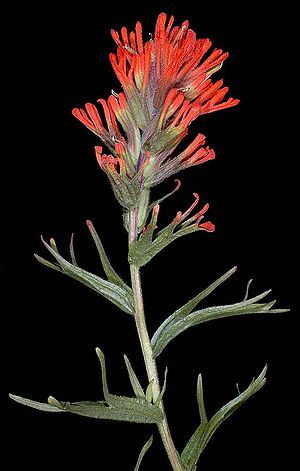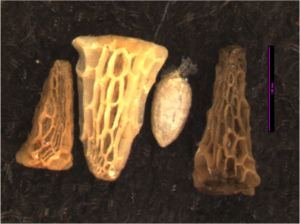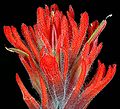Difference between revisions of "Castilleja hispida"
m (→Uses) (Tag: VisualEditor) |
m (Tag: VisualEditor) |
||
| Line 1: | Line 1: | ||
| + | * Latin Name: ''Castilleja'' ''hispida'' | ||
| + | * Family: Orobanchaceae | ||
| + | * Common Names: harsh paintbrush | ||
| + | * Codon: CASHIS | ||
{{Taxobox | {{Taxobox | ||
| name = Castilleja hispida| image = CAHI_GDCarr_flw1_good.jpg | | name = Castilleja hispida| image = CAHI_GDCarr_flw1_good.jpg | ||
| Line 17: | Line 21: | ||
| synonyms = | | synonyms = | ||
}} | }} | ||
| − | |||
| − | |||
| − | |||
| Line 107: | Line 108: | ||
http://depts.washington.edu/propplnt/Plants/castilleja%20hispida.htm | http://depts.washington.edu/propplnt/Plants/castilleja%20hispida.htm | ||
http://herb.umd.umich.edu/herb/search.pl | http://herb.umd.umich.edu/herb/search.pl | ||
| + | <references /> | ||
Revision as of 19:02, 2 June 2020
- Latin Name: Castilleja hispida
- Family: Orobanchaceae
- Common Names: harsh paintbrush
- Codon: CASHIS
| Castilleja hispida | |
|---|---|

| |
| Castilleja hispida | |
| Scientific classification | |
| Kingdom: | Plantae |
| Subkingdom: | Tracheobionta |
| Phylum: | Spermatophyta |
| Subphylum: | Magnoliophyta |
| Class: | Magnoliopsida |
| Subclass: | Asteridae |
| Order: | Scrophulariales |
| Family: | Scrophulariaceae |
| Genus: | Castilleja Mutis ex L. f. |
| Species: | C. hispida Benth. |
Contents
Description
General: Perennial, the stems mostly unbranched, clustered, erect or ascending from a woody base, 2-6 dm. tall, finely villous. Leaves: Leaves alternate, lanceolate or broader, finely villous, the lower ones entire and reduced; upper leaves with 1-2 pairs of lateral lobes, these much narrower than the mid-blade. Flowers: Inflorescence showy, short and broad, becoming elongate, scarlet or red, occasionally yellow; bracts broad and deeply 3- to 5-lobed; calyx 15-30 mm. long, deeply cleft above and below, its primary lobes again divided into 2 segments; corolla 20-40 mm. long, its puberulent upper lip about equaling the tube, the lower lip only 1/5 as long, dark green, thickened; stamens 4. Fruit: Capsule.
Bloom Period
Late April - August
Distribution
Both sides of the Cascades, British Columbia to Oregon, east to Montana.
Habitat
Grassy slopes and forest openings, from sea level to moderate elevations in the mountains.
Uses
Ecology and Wildlife
Pollinator food source. Important host plant for the federally endangered Taylor’s checkerspot butterfly. High palatability for browsing and grazing animals.
First Nations
Used to trap hummingbirds after being covered with snail slime, as well as its nectar being a source of candy for the Nitinaht.[1]
Propagation
a) SEED PROPAGATION
seed
Seed sample from: 2011
Average Measurement: 1.5 x 0.9 x 0.9
Measurement Range: L: 1.1 – 2, W: 0.6 – 1.2, D: 0.6 – 1.1
Features
Shape: Seed coat cone shaped, tapered at hilum, broadening at opposite apex. Inner seed rice shaped.
Color: Tan seed coat, inner seed slightly darker.
Surface: Seed coat papery and honeycombed with slight luster. Inner seed laterally striate and matte.
Could be confused with: Castilleja levisecta
Latitudinal Cross Section: elliptical 
Longitudinal Cross Section: obovate ![]()
Basic Explanations and Assumptions:
The dimensions for the seeds are length x width x depth. The location of the hilum is used as the base of the seed, and the length is measured from hilum to the opposite apex. Where a style is present, the length is measured from the hilum to the bottom of the style. Width is measured at a right angle to the length at the widest part. Depth is measured at a right angle to the intersection of height and width lines.
Measurements included are the mean average for each measurement of ten separate seeds.
All measurements in millimeters unless otherwise noted.
Photo Gallery
References
http://plants.usda.gov/java/charProfile?symbol=CAHI9 http://biology.burke.washington.edu/herbarium/imagecollection.php http://depts.washington.edu/propplnt/Plants/castilleja%20hispida.htm http://herb.umd.umich.edu/herb/search.pl
- ↑ Native American Ethnobotany Database. Retrieved from http://naeb.brit.org/uses/search/?string=castilleja+hispida




